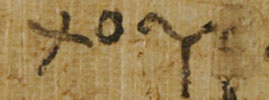
In documents from the ancient world, mistakes were frequently made by scribes hastily writing out documents. These errors could be corrected in a variety of ways. Scribes did not usually discard a papyrus because of an error; papyrus was too expensive to be thrown away. In this document, we can note four different ways in which the scribe fixed his errors.

If a word or, as in this case, a letter was forgotten, it was often written above the mistake, in the space between the lines. In this instance, the scribe intended to write the phrase ἀπόλωλέμ μοι, but forgot to write two μ's in a row. He then added the second μ in the space above the current line.

Sometimes, scribes corrected the form of the mistaken letter. Here, the scribe was writing the word νυκτόϲ, but first wrote μ when a ν was intended. The scribe corrected the text by writing the ν over top of the mistake.

Scribes also erased letters that they had accidentally written. In this case, the scribe added a ϲ to the word κληρούχου. When he realized his mistake, he erased the letter. You can still make out traces of the ϲ within the smudged text.

In extreme cases, the scribe may have erased a part of the text and written over top of the erasure. The scribe appears to have made a significant mistake when writing out the name of the chief policeman, Alexandros. The erasure is apparent at the end of the name Αλεξάνδρωι. After erasing his mistake, the scribe wrote the proper text on top.